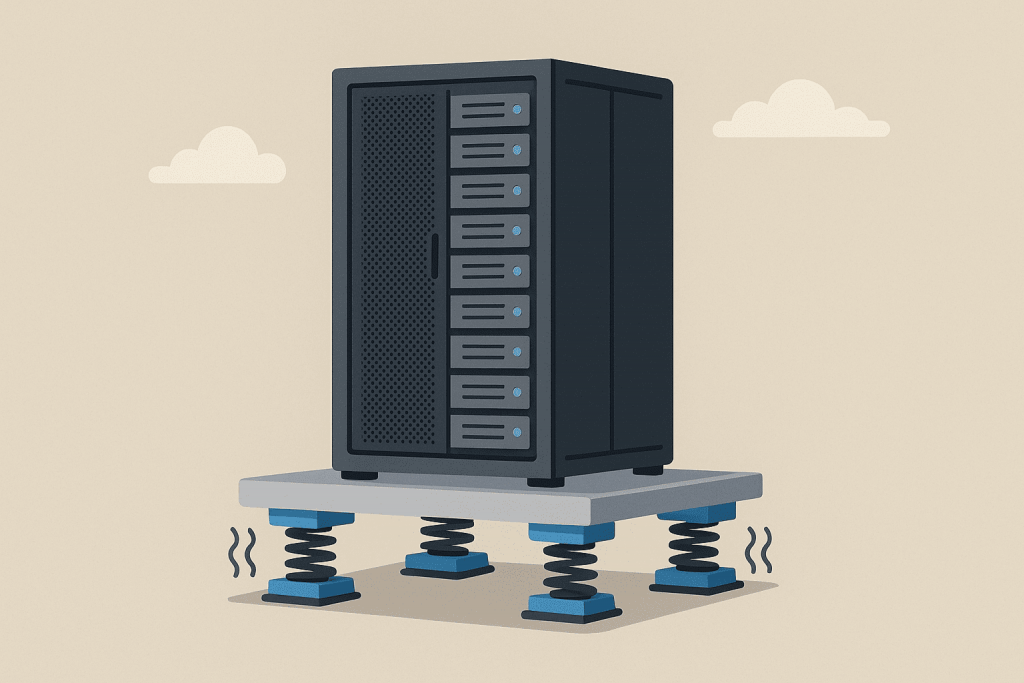
Modern data centers are not just rooms filled with servers. They are complex engineering systems where every detail matters — from air temperature and humidity to the slightest floor vibrations. One of the least noticeable yet critically important factors for stable server performance is vibration. It can cause microscopic failures in hard drives, accelerate component wear, and, under heavy load, even lead to hardware failure. That’s why engineers pay great attention to isolating vibrations inside data centers.
Where Vibrations Come From
It might seem that a server room is a quiet place with a steady hum of fans. In reality, large data centers host hundreds of sources of mechanical vibrations. These can be caused by air conditioners, cooling pumps, fans, uninterruptible power supply (UPS) units, or even external factors — such as nearby tram lines or passing trucks. Each of these sources creates microvibrations that travel through the floor and building structures to the server racks.
At first glance, it may seem trivial, but even micrometer-scale shifts can affect the precision of mechanical components in hard drives. For solid-state drives (SSD), the problem is smaller, but they too can suffer from periodic resonant vibrations that impact connectors or circuit boards.
Why Servers Are So Sensitive
A server rack is a metal frame that holds dozens of devices: servers, routers, power units, and more. It transfers all vibrations directly to the equipment. If a powerful fan or an air conditioning compressor operates nearby, the vibrations can create microresonance.
Traditional mechanical hard drives (HDDs) are especially sensitive to this. Their read heads move just a few nanometers above the disk surface, so even minor vibration can alter their trajectory. This causes repeated reads, lower performance, and faster wear. Some studies show that IOPS (input/output operations per second) can drop by half due to mechanical vibrations invisible to the human eye.
Floating Floors as the First Line of Defense
Most data centers use what’s called a floating floor — a structure where metal panels are mounted on adjustable pedestals, creating a gap between the concrete slab and the surface technicians walk on. This space is used for cable routing and airflow, but it also plays an important role in damping vibrations.
The floor isn’t rigidly connected to the building structure — it features shock absorbers or rubber pads that absorb mechanical oscillations. As a result, even if a train passes nearby or a generator is running outside, vibrations don’t directly reach the server racks.
Shock-Absorbing Systems Under the Racks
For additional isolation, engineers use special anti-vibration platforms or dampers. These can be layers of elastomer (a material similar to hard rubber), metal springs, or pneumatic cushions.
Pneumatic isolation works by “suspending” the rack on air bladders: when a vibration occurs, the air compresses and reduces the force transmitted upward. Such solutions are especially popular in high-density data centers, where a single rack can weigh more than a ton.
Another approach is to mount racks on special metal-and-rubber anti-vibration supports. These are tuned to a specific resonance frequency to counteract the most common vibration patterns in the room.
Isolation at the Building Level
In state-of-the-art data centers, vibration isolation starts at the construction phase. For example, server halls can be separated from technical rooms with concrete layers or even built on independent foundations.
Sometimes, seismic isolation technologies are used — special platforms that allow the building to move independently from the ground during an earthquake or strong vibrations. This not only makes the facility safer but also allows the data center to remain operational even after seismic events.
External units — such as cooling systems, compressors, or generators — are often installed on separate platforms divided by concrete or rubber layers. This prevents noise and vibrations from transferring into the server infrastructure.
The Role of Monitoring and Diagnostics
Modern data centers rely not only on mechanical protection but also on electronic monitoring systems. Vibration sensors — accelerometers — can be installed under the floor and inside the racks to detect even the slightest deviations. If vibration levels rise, the system sends alerts to technicians, allowing them to quickly locate the source of the issue — such as an unbalanced fan or a faulty pump.
This is essential because vibrations are not always felt or heard. Yet prolonged, even low-level vibration, if left unaddressed, can reduce the lifespan of servers by several years.
Why It Matters for Reliability
In a world where every second of downtime means financial loss, even small details can make a big difference. Vibration isolation is not a luxury or an excessive precaution — it’s one of the foundations of data center stability. It ensures that servers operate in a steady, predictable environment free from mechanical stress, reducing the risk of failures and simplifying maintenance planning.
So when we see a website or cloud service running seamlessly, even during storms or earthquakes, it’s worth remembering — behind that stability stands not just software, but also carefully engineered physical infrastructure. Sometimes, the invisible elements — like vibration damping — are exactly what make reliability possible.

Sunny
Vibrations may seem tiny, but they matter a lot for reliability, and it’s great to see data centers treating every detail with care. This kind of behind-the-scenes engineering really makes the tech we rely on run smoothly.